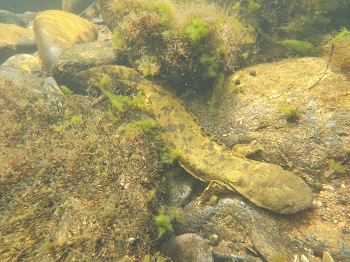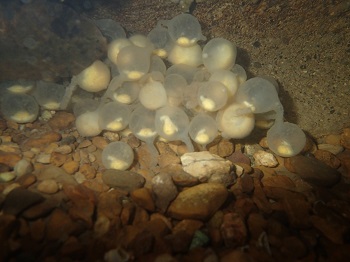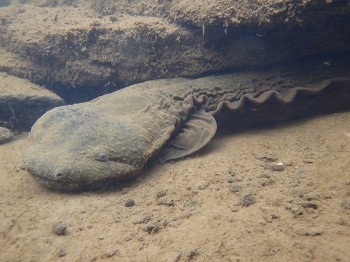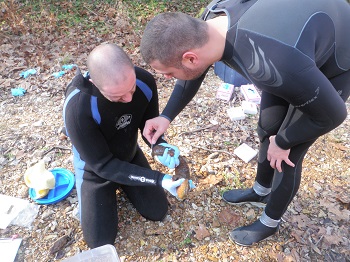Hellbenders need help!
Threats to these giant amphibians could spell trouble for everyone

Thick slime covers a hellbender’s skin. This helps protect the animal from predators and infections. But North America’s largest amphibian faces multiple threats, including habitat destruction, pollution and climate change.
USFWSmidwest/Flickr (CC-BY-2.0)
Many people call hellbenders “snot otters.” And for good reason.
“When you touch one, it produces huge amounts of slime,” explains Emily McCallen. “It really does feel like snot.” McCallen is studying hellbenders as a graduate student in forestry and natural resources at Purdue University in West Lafayette, Ind.
Hellbenders are not otters, though. They’re salamanders — and North America’s biggest amphibians. Their “snot” or slime is actually a layer of mucus. It helps protect the adults.
That slime can help the animal slip away from danger. “It’s impossible to hold onto one with your bare hands,” says Kim Terrell. “They are like an eel dipped in Crisco.” Terrell is a wildlife biologist with the Smithsonian Conservation Biology Institute in Washington, D.C.

Still, these giant salamanders are in trouble. Their habitats have shrunk. They battle pollution. And many are getting sick, despite their protective “snot.” Climate change is making matters worse. As a result, populations in many areas are shrinking or even disappearing. That could spell bad news for hellbenders — and for the rest of us.
“Hellbenders indicate a healthy system,” explains Williams. “When they’re not found any more, there’s something going on in the water. And we need to pay attention to that.”
Fortunately, scientists are paying attention. And they’re stepping in to help.
Prehistoric creatures
No one is quite sure how these animals got their common name. But with their flat gray-brown bodies, wrinkly skin, stubby limbs and tiny eyes, hellbenders look like they belong in prehistoric times.
These creatures spend their whole lives in water. There they hatch from eggs as larvae. At that early stage, the young amphibians breathe through gills. Later, their bodies go through a huge change called metamorphosis. Eventually they grow to lengths of up to 74 centimeters (29 inches).

Because hellbenders breathe through their skin, they need clean water to live in. And not all waterways offer that any more. They prefer to make their homes in clear, cold, fast-flowing streams, Lipps says.
While the water around them flows fast, adults generally stay put. Except for mating season, hellbenders usually hang out under large river rocks. They feast on crawfish or other tasty treats that swim by.
Hellbenders are split into two groups, called subspecies. The range for the Eastern hellbender subspecies stretches from New York in the north and east, to Missouri in the west and to Alabama in the south. The Ozark hellbender subspecies lives only in parts of Missouri and Arkansas.
The two subspecies don’t occur in the same rivers, observes Rod Williams. He’s a wildlife scientist at Purdue University. And even if they were in the same rivers, they wouldn’t mate. Their breeding seasons are about a month apart.

After two-and-a-half months, hundreds of larvae hatch and swim away. Those huge numbers are important because a young hellbender’s life is hard. Only a few survive to adulthood, mainly because the young make tasty treats for fish and other animals. Still, hellbender populations had been mostly holding on fine and at times even growing — until recently.
Home wreckers
Hellbenders have already disappeared from some of the streams in which they once lived. In Indiana, for example, only the Blue River still hosts hellbenders. Many streams in other states have just a few older animals left. That’s because humans have ruined their habitats in many places.
“Without a doubt, the biggest current threat hellbenders face is increased sediment and silt entering the waterways where they live,” explains Lipps. In many regions, cities and suburbs have replaced forested areas. Without wild trees and brush to hold back rainwater, the water carries silt and sediment into streams. The material washes into rivers from farms, roads and construction and drilling sites. It can cover rocks where hellbenders nest. In extreme cases, hellbenders can suffocate.

In recent years, biologists have been finding fewer and fewer young hellbenders in many wild streams. “Something is happening to them at a very early stage,” says Jeff Ettling. He’s a herpetologist at the Saint Louis Zoo in Missouri.
Toxic chemicals are another problem. Because hellbenders live in water and breathe through their skin, they are very sensitive to pollution. Rain that runs off the land after storms can carry pesticides, weed killers and fertilizer into streams. City wastewater plants also discharge low levels of medicines that humans had excreted when they used their toilets.
Removing water for fracking or other uses can make problems worse, Lipps says. When there is less water in a stream, it flows more slowly. Now, any pollution in the water will become concentrated.
“Climate change represents another stress,” says Terrell at the Smithsonian. Warmer water holds less dissolved oxygen than cold water does. Terrell’s research suggests that hellbenders are already living close to their upper temperature limit. Extreme temperatures pose the biggest danger. “When that really, really hot week in July or August hits, it may push hellbenders beyond their limit,” she says.
Climate change could also reduce the difference between daytime and nighttime temperatures. That might not seem like a problem, but Terrell’s group discovered something disturbing when they mimicked in the lab those natural daily temperature shifts seen in summer months. Animals in tanks where the temperature changed from night to day showed improved immunity to certain diseases compared with a control group held under constant water temperatures. If climate change reduces the daily swings between high and low temperatures, hellbenders’ health could suffer, the researchers concluded in the Journal of Experimental Biology in November 2013.
Disease is already causing problems, especially for the Ozark subspecies. One disease, known as amphibian chytrid fungus, may have come from African clawed frogs. These frogs have been used in many research labs and some were inappropriately released into the wild. For amphibians, the fungus causes multiple problems, Ettling says. For starters, it hardens the skin. When this happens, hellbenders have trouble breathing. Even worse, he says, the disease can allow secondary infections to set in, such as those caused by flesh-eating bacteria.
“Many of these stressors can act synergistically,” notes Lipps in Ohio. That means they can act together. And the combination is often worse than the sum of each stressor alone.
Sadly, people are a threat too. “We still get a lot of stories about people killing them,” says Williams in North Carolina. Contrary to some myths, hellbenders are not bad for fish in a river. “They’re part of a healthy system.”
Taking action
In 2011, the Saint Louis Zoo started the first captive-breeding program for hellbenders. Getting hellbenders to reproduce at the zoo, though, wasn’t as straightforward as putting two salamanders into a tank of water. Successful matings took years of trial and error, explains Ettling. One key factor, his team found, was mineral levels in the water. The scientists described how they figured that out in the December 2013 issue of Herpetological Review.

Both the captive-breeding and head-start programs release young hellbenders into the wild starting at about age three. By then, the animals are around 24 centimeters (9.4 inches) long. That’s big enough to escape many predators.
Follow-up studies show that about one in every four of these young survive after their release, says Rod Williams at Purdue. Most of the young also stay in the area where they are released. Researchers don’t want to put too many siblings into any one area. They now know to release the young at different spots if they want to reduce the possibility of inbreeding. Inbreeding occurs when two closely related individuals produce offspring. It can lead to an increase in genetic disorders.
For now, scientists release most captive-bred hellbenders into streams where the numbers of their wild-born kin are low. Future releases could be in places where water conditions have improved enough that lost communities might be restored.
“We want to find good solid habitat to release them in the future,” says McCallen at Purdue. One of her projects uses underwater sonar to map streambed features. Using computers, she will analyze those data, along with information from surface maps. Her goal is to identify the best places for hellbenders to live.
Spying DNA
High-tech tools also can help hellbenders. DNA testing is one tool that makes field surveys easier. With this tool, scientists don’t need to find hellbenders in their hiding spots. Instead, the method detects the salamanders’ genetic material in a sample of river water. If the results are positive, then at least one animal is living within a kilometer (0.6 mile) of the sampling site.

Scientists also have been comparing the DNA of hellbenders from dozens of rivers in different states. Populations from different rivers “could turn out to be either new species or subspecies,” says Ettling at the Saint Louis Zoo. Already Rod Williams and his colleagues found many genetic differences between Eastern hellbenders in the Ohio and Tennessee River basins. PLOS ONE published their findings in October 2013.
Low-tech approaches also can help hellbenders. One solution that Lipps promotes in his talks to Ohio landowners is planting trees. Trees anchor the soil so it won’t wash away and eventually smother the hellbender’s river habitat. Trees reduce stream bank erosion for landowners, too. That makes them a win-win.
“We’ve got about 30 years to get the streams cleaned,” Lipps says. After that, hellbenders might have few, if any, homes left in the wild.

Hellbenders are a good indicator of an ecosystem’s health. If they’re doing well, water quality and other conditions are also probably good. If they’re in trouble, then other species in the system can probably expect problems. After all, amphibians are very sensitive to the environment. “Since they respire through their skin, they soak up anything in the environment,” notes Ettling.
The hellbender species has been around for hundreds of thousands of years. “When we see that they’re declining,” Lipps says, “we should be really scared.”
Power Words
(for more about Power Words, click here)
antibacterial Having properties that tend to destroy or limit the growth or reproduction of bacteria.
antifungal Having properties that prevent or limit the growth of fungi.
amphibians A group of animals that includes frogs, salamanders and caecilians. Amphibians have backbones and can breathe through their skin. Unlike reptiles, birds and mammals, unborn or unhatched amphibians do not develop in a special protective sac called an amniotic sac.
bacterium (plural bacteria) A single-celled organism. These dwell nearly everywhere on Earth, from the bottom of the sea to inside animals.
biology The study of living things. The scientists who study them are known as biologists.
captive breeding The breeding of an animal, often a species threatened with extinction, in a protected environment. The species is often raised in part to supply animals for reintroduction back into the wild.
climate change Long-term, significant change in the climate of Earth. It can happen naturally or in response to human activities, including the burning of fossil fuels and clearing of forests.
conservation The act of preserving or protecting the natural environment.
conservation biologist A scientist who investigates strategies for helping preserve ecosystems and especially species that are in danger of extinction.
DNA (short for deoxyribonucleic acid) A long, double-stranded and spiral-shaped molecule inside most living cells that carries genetic instructions. In all living things, from plants and animals to microbes, these instructions tell cells which molecules to make.
ecosystem A group of interacting living organisms — including microorganisms, plants and animals — and their physical environment within a particular climate. Examples include tropical reefs, rainforests, alpine meadows and polar tundra.
fracking, or hydraulic fracturing The cracking open of undergound rocks by introducing liquid at high pressure, especially to extract natural gas. Those cracks are then held open by sand that had been added to the fracking fluid.
fungus (plural: fungi) One of a group of single- or multiple-celled organisms that reproduce via spores and feed on living or decaying organic matter. Examples include mold, yeasts and mushrooms.
gene (adj. genetic) A segment of DNA that codes, or holds instructions, for producing a protein. Offspring inherit genes from their parents. Genes influence how an organism looks and behaves.
genetic Having to do with chromosomes, DNA and the genes contained within DNA. The field of science dealing with these biological instructions is known as genetics. People who work in this field are geneticists.
graduate student Someone working toward an advanced degree by taking classes and performing research. This work is done after the student has already graduated from college (usually with a four-year degree).
habitat The area or natural environment in which an animal or plant normally lives, such as a desert, coral reef or freshwater lake. A habitat can be home to thousands of different species.
herpetology The biology of reptiles and amphibians.Scientists who work in this field are known as herpetologists.
immunity The ability of an organism to resist a particular infection or poison by producing and releasing special protective cells.
inbreeding The mating of animals that are too closely related, genetically. It is the opposite of genetic diversity. Animals that are inbred tend to become weak or sickly and often cannot reproduce successfully.
larva (plural: larvae) An immature life stage of certain animals, which often has a distinctly different form as an adult.
mammal A warm-blooded animal distinguished by the possession of hair or fur, the secretion of milk by females for feeding the young, and (typically) the bearing of live young.
metamorphosis A dramatic change from one stage in an animal’s life history to the next, such as the process by which a tadpole becomes a frog or the changes that transform a caterpillar into a butterfly.
oxygen A gas that makes up about 21 percent of the atmosphere. All animals and many microorganisms need oxygen to fuel their metabolism.
pesticide A chemical or mix of compounds used to kill insects, rodents or other organisms harmful to cultivated plants, pet or livestock, or unwanted organisms that infest homes, offices, farm buildings and other protected structures.
population A group of individuals from the same species that lives in the same area.
predator (adjective: predatory) A creature that preys on other animals for most or all of its food.
range In biology, the geographic area over which an organism can be found. In math or for measurements, the extent to which variation in values is possible.
reptile Cold-blooded vertebrate animals, whose skin is covered with scales or horny plates. Snakes, turtles, lizards and alligators are all reptiles.
runoff The water that runs off of land into rivers, lakes and the seas. As that water travels over land, it picks up bits of soil and chemicals that it will later deposit as pollutants in the water.
sediment Material (such as stones and sand) deposited by water, wind or glaciers.
silt Very fine mineral particles or grains present in soil. They can be made of sand or other materials. When materials of this size make up most of the particles in soil, the composite is referred to as clay. Silt is formed by the erosion of rocks, and then usually deposited elsewhere by wind, water or glaciers.
sonar A system for the detection of objects and for measuring the depth of water. It works by emitting sound pulses and measuring how long it takes the echoes to return.
species A group of similar organisms capable of producing offspring that can survive and reproduce.
subspecies A subdivision of a species, usually based on geographic separations. Over time, this separation may have allowed some of the genes in a population of a species to vary, creating differences in those organisms’ appearance or adaptation to the local environment.
synergy (adj.synergistic) The combined effect of two or more things to produce a total impact that is greater than the sum of the individual parts.
toxic Poisonous or able to harm or kill cells, tissues or whole organisms. The measure of risk posed by such a poison is its toxicity.
Readability Score: 7.5
Word Find (click here to enlarge for printing)








